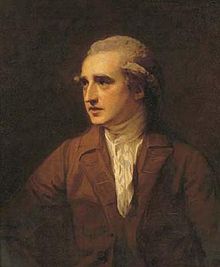- Charles Francis Greville
-
Charles Francis Greville FRS (12 May 1749–1809), a younger son of Francis Greville, 1st Earl of Warwick, was a British antiquarian and collector. He is the founder of the port of Milford Haven.[1]
Life
Greville lived on a stringent income of ₤500 a year, but managed to acquire antiquities from Gavin Hamilton in Rome. He also purchased through his uncle a genre piece by Annibale Carracci.[2] As a Fellow of the Royal Society, his special interest was in minerals and precious stones, which were catalogued by the émigré Jacques Louis, comte de Bournon[3] and were later purchased via Act of Parliament for the British Museum. He was good friends with James Smithson, whom he sponsored for membership in the Royal Society and with whom he exchanged minerals.[4] When his father died in 1773 and his brother became Earl of Warwick, Charles Greville inherited his seat of Warwick in the House of Commons.
Greville remained for years a very close friend of Sir Joseph Banks and, like him, a member of the Society of Dilettanti. He accompanied Sir Joseph at the organizing meeting in March 1804 of the precursor to the Royal Horticultural Society, the Society for the Improvement of Horticulture.[5]
The nephew of Sir William Hamilton,[6] the British envoy at Naples who formed two collections of Greek vases, one of which is at the British Museum, Greville briefly (1782–86) had for a mistress Emma Hart, whom he educated and took to George Romney's studio where he was sitting for his own portrait; Romney became fascinated with the beautiful Emma,[7] who later became Sir William's Lady Hamilton and eventually Lord Nelson's lover. Greville never married; he predeceased his brother, the second earl. He lived for years in a house facing Paddington Green, then a suburban district of London, where he indulged his passion for gardening in a large garden provided with glasshouses in which he grew many rare tropical plants, aided by his connection with Banks, and where he managed to coax Vanilla planifolia to flower for the first time under glass, in the winter of 1806-07.[8] His contributions to the herbarium assembled by Sir James Edward Smith are preserved by the Linnaean Society of London.[9] The Australasian genus Grevillea is named in his honour. In the latter part of his life he lived at Warwick Castle.
The construction of the seaport of Milford Haven, Pembrokeshire, South Wales, is due to his entrepreneurial spirit; when it was the property of Sir William Hamilton, Charles Greville applied for an act of Parliament to enable Sir William and his heirs to make docks, construct quays, establish markets, with roads and avenues to the port, to regulate the police, and make the place a station for conveying the mails.[1] The first structure was a coaching inn. Natives of Nantucket were induced to settle, and for some decades Milford was a whaling port. A royal dockyard was established during the Napoleonic Wars.[10] At his death in 1803, Sir William bequeathed it to his nephew.[11]
Greville Island, in the South Island of New Zealand, was named to honour his memory by Ensign Barallier, in 1820.[12]
Greville plays a role in Susan Sontag's 1992 novel The Volcano Lover, about Sir William Hamilton.
Notes
- ^ a b Charles Francis Greville, Welsh Biography Online, accessed October 2010
- ^ It is now in the Metropolitan Museum of Art: Two Children Teasing a Cat, attributed to Annibale Carracci.
- ^ Jacques Louis, comte de Bournon (1751–1825), is commemorated in bournonite.
- ^ Heather Ewing, The Lost World of James Smithson: Science, Revolution, and the Birth of the Smithsonian, (New York and London: Bloomsbury, 2007), pp. 118, 127-37.
- ^ Tim Ecott, and Hubert Selby, Vanilla: Travels In Search Of The Ice Cream Orchid (Grove Press) 2005, pp 84ff.
- ^ Greville's mother was Lady Elizabeth Douglas-Hamilton, Countess of Warwick.
- ^ He painted allegorical "fancy pictures" of Emma in various guises forty-five times. (Fitzgerald Molloy, Sir Joshua and His Circle (Hutchinson) 1906, vol. II p. 490).
- ^ Ecott and Selby 2005:87.
- ^ John Edmondson and Claire Smith, "The Linnean Society's Smith Herbarium: A Resource for Eighteenth-Century Garden History Research" Garden History 27.2 (Winter 1999:244-252) p. 249 (list).
- ^ 'Michael-Church - Monkton', A Topographical Dictionary of Wales (1849), pp. 213-23. URL: http://www.british-history.ac.uk/report.asp?compid=47869. Date accessed: 18 March 2007.
- ^ J. F. Rees, The Story of Milford, (University of Wales Press) 1954, details the largely unsuccessful efforts to create a rival port to Liverpool.
- ^ Ernest Favenc, The History of Australian Exploration, chapter 18.
Parliament of Great Britain Preceded by
Lord Greville
Paul MethuenMember of Parliament for Warwick
with Paul Methuen 1774
Hon. Robert Fulke Greville 1774–1780
Robert Ladbroke 1780–1790
1774–1790Succeeded by
The Lord Arden
Major Henry GagePolitical offices Preceded by
The Earl of EffinghamTreasurer of the Household
1783–1784Succeeded by
The Earl of CourtownPreceded by
Lord HerbertVice-Chamberlain of the Household
1794–1804Succeeded by
Lord John ThynneCategories:- 1749 births
- 1809 deaths
- British businesspeople
- British MPs 1774–1780
- British MPs 1780–1784
- British MPs 1784–1790
- Fellows of the Royal Society
- Lords of the Admiralty
- Members of the Parliament of Great Britain for English constituencies
- Members of the Privy Council of Great Britain
- Treasurers of the Household
- Younger sons of earls
- Milford Haven
- People associated with the British Museum
Wikimedia Foundation. 2010.

